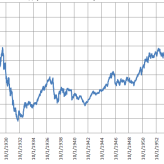
In an era of unprecedented computerized trading, it’s estimated that over 60% of all buy and sell transactions for any asset class (stocks, options, futures, etc.) are performed by computers operating autonomously via algorithms. So why does this matter for the typical buy and hold investor who buys stock and waits a decade?
Well, it matters because it suggests there might be other factors beyond speculation, hedging, and supply/demand that influence the price of stocks. Algorithms make decisions to buy or sell thousands of stocks for periods of a few seconds, minutes, and even weeks based on many different and often secret determinants. One technical factor that is taken into consideration for most algorithms, which is available to anyone who has the gumption to look, is known as “the expected move.”
Knowing what the expected move means, at the very least, levels the playing field between billion dollar HFT funds and mom-and-pop investors.
At it’s core, the expected move is the amount an underlying asset is expected to move either up or down in a given time period. Magnitude and duration of the expected move can very immensely depending on pending binary events and the historical volatility of the asset.
Essentially, an expected move is derived from the pricing and implied volatility of at-the-money options contracts for the underlying instrument. For example, if volatility is high for January gold options, the expected move will, in general, be large. Conversely, if volatility is low in the options, then the expected move will be very small, because the market is not pricing in dramatic movement either up or down, so investors don’t see the need to pay hefty premiums to protect their positions.
What this means is, market makers and institutional participants who set the prices (and therefore set volatility) for these options have a huge impact on the range that any security will trade in and therefore a significant impact on almost every investor’s profits/loss. These “liquidity providers” determine the probabilistic range that a security will go up or down for the day, month and even entire year.
Unfortunately, the expected move does not provide an expected direction; that would make investing too easy!
Even though the expected move doesn’t provide an expected direction, it may actually not be necessary. If an investor adheres to solid fundamental analysis for any investment, they should theoretically already know the direction their investment will move. They just won’t know the magnitude of the move, and knowing how much an investment is expected to change over time is arguably more important.
Investors couldn’t possibly know such a thing without looking at the expected move. Therefore, it’s paramount to be informed of the price change that the market is expecting to ensure that you’re not off base with the expectations of the market.
It is also important to note, however, that expected moves don’t always work in extreme situations like a black swan, for example.
Terrorists attacks, technical glitches, and unexpected events happen upon occasion. When events like this occur, the expected move is often thrown out the window. Similarly, sometimes the expected move is just plain wrong, because markets are unpredictable and often irrational. Nevertheless, for the most part, the people and computers that calculate and determine the expected move know what they’re doing, so it’s fairly accurate most of the time.
With all of this said, merely knowing what the expected move is a very useful tool for investors, day traders, and even long-term options traders to have in their toolbox, because knowing what to expect in the market is the first step towards knowing how to take advantage of it.


Thanks for the info.